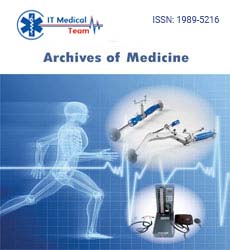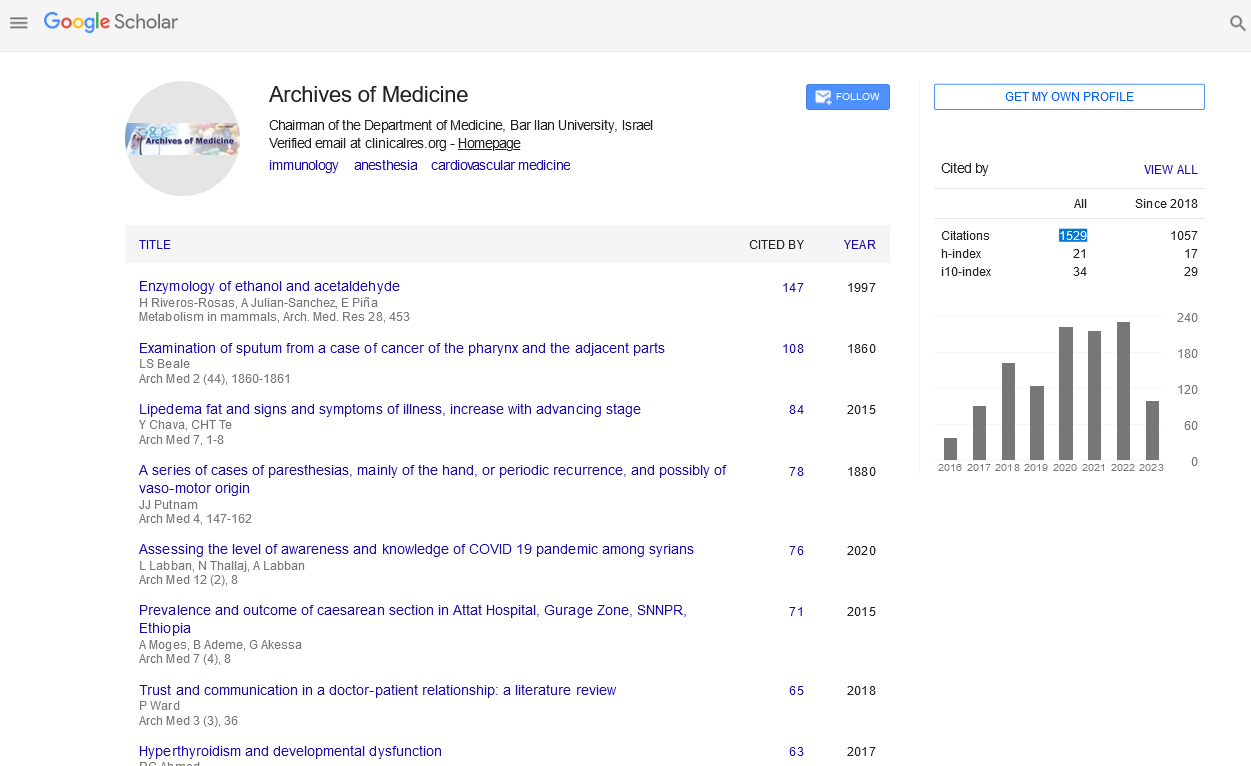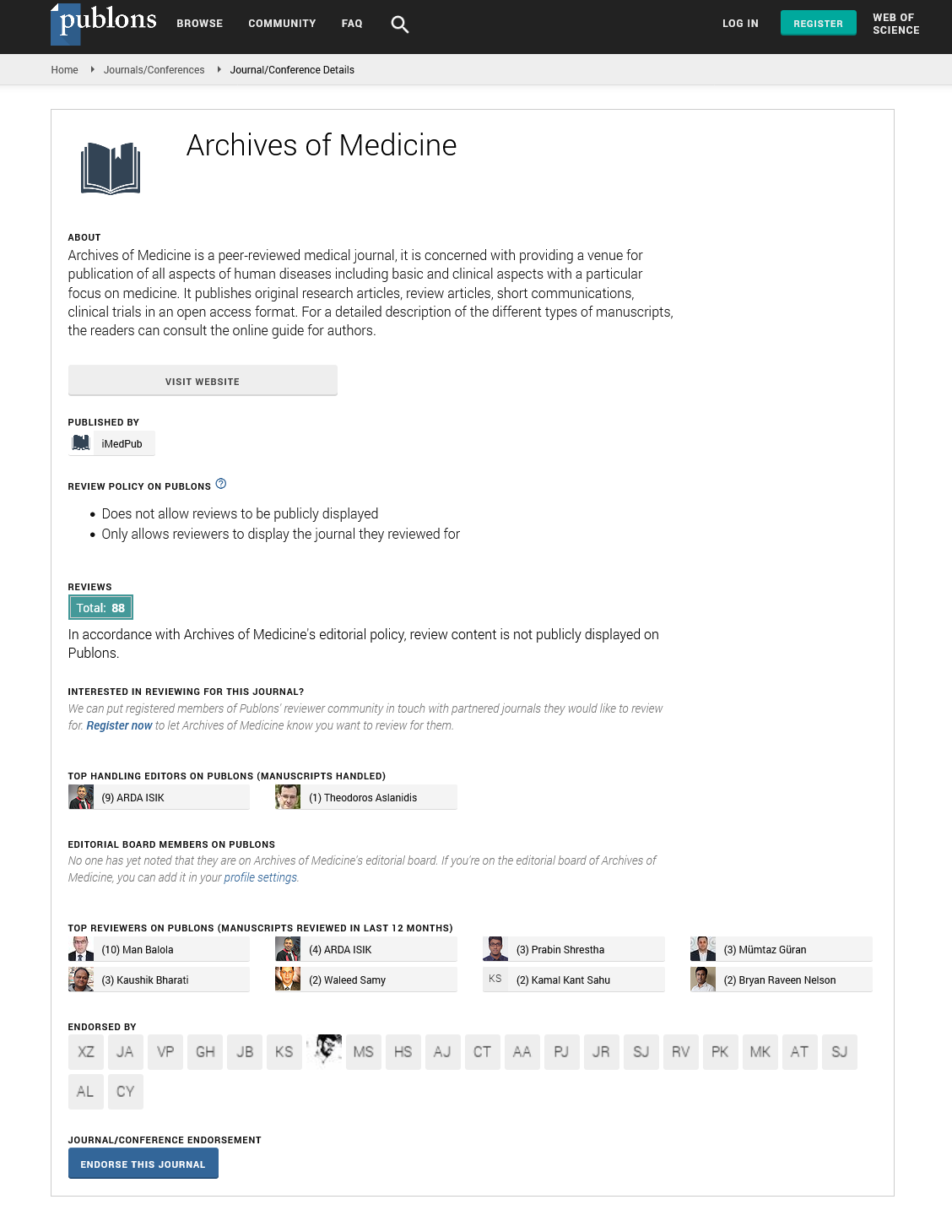Mini Review - (2022) Volume 14, Issue 9
Analysis of viral metagenomes in stool samples from qatari children with untreated gastroenteritis
Carolina Palmblad*
Department of Medicine, Karolinska University Hospital Huddinge, Stockholm, Sweden
*Correspondence:
Carolina Palmblad, Department of Medicine, Karolinska University Hospital Huddinge, Stockholm,
Sweden,
Email:
Received: 01-Sep-2022, Manuscript No. ipaom-22-13246;
Editor assigned: 03-Sep-2022, Pre QC No. P-13246;
Reviewed: 09-Sep-2022, QC No. Q-13246;
Revised: 15-Sep-2022, Manuscript No. R-13246;
Published:
21-Sep-2022
Abstract
All over the world, acute gastroenteritis is a major health issue,
particularly for children living in developing nations. Diarrhea is
the fourth leading cause of child mortality, following intrapartum
diseases, lower respiratory infections, and complications associated
with preterm birth. Viruses like rotavirus, norovirus, adenovirus,
and astrovirus typically cause diarrhea in children. Around the
world, rotavirus infections are still a major cause of diarrhea-related
death in children under the age of five. In developed nations,
rotavirus vaccines already save lives, but in developing nations, they
are less effective due to higher rates of early rotavirus infection
transmission and inadequate vaccination coverage or accessibility.
Additionally, bacteria such as Campylobacter spp. and parasites such
as Cryptosporidium spp. and Giardia lamblia, AGE is primarily caused
by Clostridium difficile and other bacteria.
Keywords
Gastroenteritis; Rotavirus; Diarrhea
INTRODUCTION
The Global burden of diseases (GBD) study looked at
diarrhea-related deaths and causes in 195 countries between
1990 and 2016.The authors claim that campylobacter spp. and rotavirus were the most common causes of diarrhea
in children younger than five years old. In a similar vein,
the Global Enteric Multicenter Study (GEMS) reported
that rotavirus, Cryptosporidium spp., and enterotoxigenic
E.coli four pathogens were responsible for the majority of
moderate-to-severe diarrhea in children under five in sub-
Saharan Africa and South Asia: Despite advancements in
molecular diagnosis, the etiology of numerous outbreaks
remains unsolved using conventional diagnostic methods.
These include Shigella species and enterotoxigenic E. coli with a heat-stable toxin. These commercially available
assays are not suitable for the detection of novel or
unusual pathogens, variant strains, or known or common
pathogens associated with the disease. Next-generation
sequencing (NGS) enables metagenomics-based virus
identification by randomly sequencing all of a clinical
or environmental sample's genomes. The conclusion
of clinical examples without earlier information on the
potential infection causing microorganisms is made
conceivable by metagenomics, which is characterized as
the grouping based investigation of the whole assortment
of genomes straightforwardly disconnected from an
example. Consequently, viral metagenomics enables the
identification of every viral sequence in the clinical sample,
regardless of whether the viruses are known, unknown, or
cultivable [1-4].
Description
In this study, we used a virus-enrichment metagenomics
strategy to examine the potential causes of cases of
gastroenteritis that were not diagnosed using stool samples
from children under the age of five. The study was approved
by the institutional review boards of Hamad Medical
Corporation and American University of Beirut. Written
informed consent was obtained from the children's parents
in order to use their samples for the study [5].
Stool samples were taken from 774 stools from
gastroenteritic children under the age of five who presented
with diarrhea at the Pediatric Emergency Center (PEC) of
the Hamad Medical Corporation (HMC) in qatar during
the study, which ran from June 2016 to August 2019. At
the time of the study, each patient resided in Qatar. The
BioFire, FilmArray, Gastrointestinal (GI) Panel was used to screen specimens, and demographic and clinical data were
extracted from the patients' medical records. All of the
symptoms of gastroenteritis were included in the 20-point
composite Vesikari score. The score is determined by seven
factors: Maximum daily number of stools, duration of
diarrhea, maximum daily number of bowel movements
duration of vomiting, temperature, dehydration, and
treatment. A 40 g portion of the stool sample was
centrifuged at 4000 gms in a buffer containing 0.89
percent NaCl (10% w/v for solid and v/v for liquid stool
suspensions). The supernatant was collected and subjected
to two additional centrifugation steps. All out RNA from
the example was removed using the QIAamp Viral RNA
Scaled down unit (Qiagen, Germany) and treated with
Super DNase (Super Sans DNA Pack, Invitrogen, USA).
The SuperScript IV first-strand synthesis system (Thermo
Fisher Scientific, USA) was used to reverse transcribe the
viral RNA and mRNA. After that, a 0.22 m filter was used to
remove both bacterial and host cells from the In accordance
with the kit's instructions, the 5′-end exonuclease Klenow
fragment (3′ 5′ exo) was added to transform the cDNA into
ds-DNA. The ds-DNA was purified using the QIAquick
purification kit from Qiagen, Germany. Purified DNA was
amplified with the REPLI-g Single Cell Kit which allows
for primer-independent amplification, to further enrich
the viral genome. The libraries, which were created in
accordance with the Nextera XT protocol were sequenced
using the Illumina HiSeq platform [6,7].
A high-throughput Galaxy analysis pipeline was set up
on a local server. The following were the pipeline's stages:
Trimming bases of low quality with Trimmomatic following
a FastQC quality check of the Fastq files. The trimmed
sequences were aligned and mapped to reference sequences
using Bowtie 2.The sequences were first mapped to a
reference human genome. Non-aligned reads were mapped
to rRNA and reference bacterial genomes in order to enrich
for viral sequences. The unaligned reads from the previous
step were then mapped to a locally hosted, indexed viral
database that was downloaded from GenBank. Utilizing
IDBA (A Reasonable Iterative de Bruijn Diagram Once
more Constructing agent), viral peruses were collected into
contigs. A local GenBank viral database was used to align
contigs with a minimum length of 100 base pairs using
MegaBLAST. Any hit with an e-value was considered
significant and subjected to additional investigation.
The viruses' genotypes were assigned based on the Mega
BLAST hit that was closest to the longest contigs mapped
to the genes used for genotyping [8-10].
Conclusion
The demographic and clinical details of the patients
whose AGE etiology was determined by metagenomics are
summarized. Seventy percent of the patients had a mean
age of less than two years, making them under the age of
three.64% of the children in the cohort had received the
rotavirus vaccine, 52% had received analgesics, and 22%
had received antibiotics. The majority of the patients
(97 percent) experienced vomiting and diarrhea, and the
majority of the children experienced mild to moderate
dehydration, with the average highest body temperature of
37.35°C.
Acknowledgement
None.
Conflict of Interest
None.
REFERENCES
- Hall AJ, Wikswo ME, Manikonda K et al. Acute gastroenteritis surveillance through the national outbreak reporting system, United States. Emerg Infect Dis. 2013;(8):1305.
Google Scholar, Crossref, Indexed at
- Lopman B, Gastanaduy P, Park GW et al. Environmental transmission of norovirus gastroenteritis. Curr opinion virol. 2012;2(1):96-102.
Google Scholar, Crossref, Indexed at
- Dey SK, Phathammavong O, Nguyen TD et al. Seasonal pattern and genotype distribution of sapovirus infection in Japan, 2003–2009. Epidemiol Infect. 2012;140(1):74-77.
Google Scholar, Crossref, Indexed at
- Hansman GS, Oka T, Okamoto R et al. Human sapovirus in clams, Japan. Emerg Infect Dis. 2007;13(4):620.
Google Scholar, Crossref, Indexed at
- Arias C, Sala MR, Dominguez A et al. Epidemiological and clinical features of norovirus gastroenteritis in outbreaks: A population-based study. Clin Microbiol Infect. 2010;16(1):39-44.
Google Scholar, Crossref, Indexed at
- Kaplan JE, Feldman R, Campbell DS et al. The frequency of a norwalk-like pattern of illness in outbreaks of acute gastroenteritis. Am J Public Health. 1982;72(12):1329-1332.
Google Scholar, Crossref, Indexed at
- Kageyama T, Kojima S, Shinohara M et al. Broadly reactive and highly sensitive assay for norwalk-like viruses based on real-time quantitative reverse transcription-PCR. J Clin Microbiol. 2003;41(4):1548-57.
Google Scholar, Crossref, Indexed at
- Oka T, Katayama K, Hansman GS et al. Detection of human sapovirus by real‐time reverse transcription‐polymerase chain reaction. J Med Virol. 2006 Oct;78(10):1347-53.
Google Scholar, Crossref, Indexed at
- Teo SM, Mok D, Pham K et al. The infant nasopharyngeal microbiome impacts severity of lower respiratory infection and risk of asthma development. Cell host microbe. 2015;17(5):704-15.
Google Scholar, Crossref, Indexed at
- Larsen JM, Brix S, Thysen AH et al. Children with asthma by school age display aberrant immune responses to pathogenic airway bacteria as infants. J Allergy Clin Immunol. 2014;133(4):1008-13.
Google Scholar, Crossref, Indexed at






